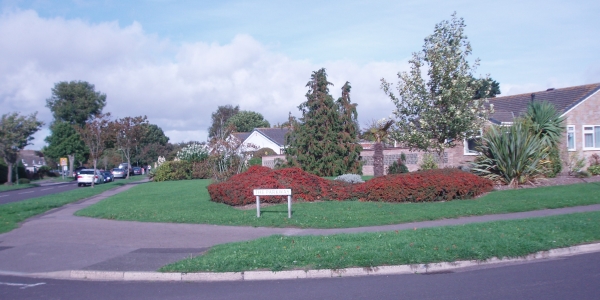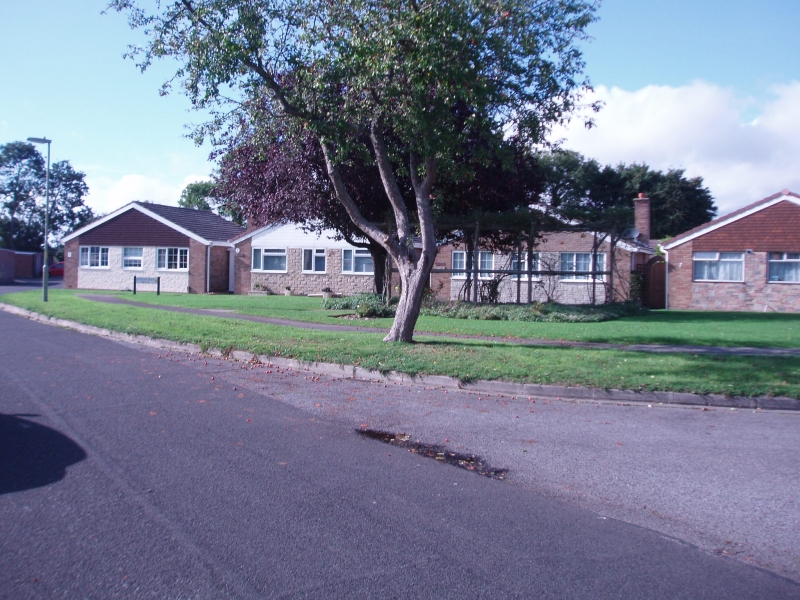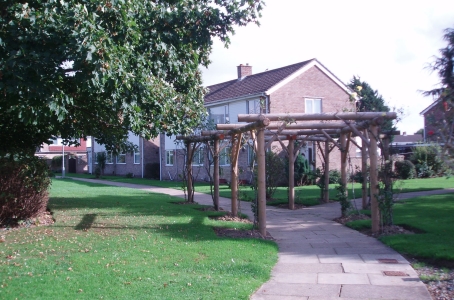PLEASE READ THE NEWS ARTICLE
The Peel Common Housing Estate – The Beginning
In the early sixties Gosport Borough in Hampshire aspired to turn itself into a garden town encompassing green areas with street lined trees and lawned borders. Out of this ambition was born the Peel Common Estate.
Peel Common is a large housing and garden complex developed on the American Radburn System with the aim of providing good homes at moderate costs in a garden environment. The grant of building permission on the Peel Common 70 acre site was limited to 544 dwellings on 30 acres of the site, the remaining land being open to lawn and garden areas. As an addition to the scheme a school was incorporated into the project including a shopping complex and a doctor's surgery. Dwellings were to front lawns and gardens with no roads breaking up the landscape. All this was to afford complete safety for children, comparative quietness from traffic noise and an air of spaciousness 'unknown to people on the conventional estate’. Every property was to have its own brick built garage within easy reach of the property.
The estate was commissioned by Metropolitan Railways Country Estates Ltd with the six phases of build starting in 1963 and completion taking seven years. Due to the uniqueness of the project strict guidelines and regulations were enforced on ownership. Each property was leasehold (999 years) with a fixed rent of £5.00. The 40 acres of garden was to be maintained by applying a yearly service charge on each dwelling. Management of the estate was to be the responsibility of the freeholder Landlord and its costs were to be limited and paid from the Service Charge. The lease provided for continuity of original conception including a clear restriction on further development.
The Future – The first 40 years
The estate was owned by Metropolitan Railways Country Estates Ltd the Freeholder whose purpose, on completion of the build, was to be the guardian of the concept. There was to be no real long term profit and in a perfect world the company would sit back and admire and take satisfaction from what it had created.
It is not however a perfect world and over the years ownership of the estate passed through the hands of various building companies. Broasley, Ideal Homes, Persimmon. Despite attempts to capitalise on the assets of the estate the restrictions on the Freeholder proved ownership was not a profitable concern and the estate bounced from one owner to another.
Despite the changes in ownership, for a period of 40 years the advantages of open areas, gardens and lawns was enjoyed by all residents. Over the years an affordable maintenance fee covered the cost of a resident gardener and his small workforce whose sole purpose was to maintain the gardens on the estate. During this period the estate was managed on behalf of the Freeholder by a management committee made up of volunteer residents. The estate proved to be a comfortable safe home living up to the expectations designed in the original founding plan.
A change of landlord - The worrying Years
In June 2005 the removal of the comfort zone encompassing the original concept, transpired. The landowner Persimmon off loaded the estate to a London based company. Initially, in an attempt to make a profit, this new company offered all house owners the opportunity to buy their Freehold. It was not successful, only a few residents took up the offer and the whole estate was promptly put up for auction. This action by the new landlord signaled the end of the line for the old Peel Common Management Committee (PCMC) which had managed the estate for approximately 37 years. The local led residents management committee was disbanded and It was during this period of uncertainty that the PCRA reformed. Following a special meeting of the estates residents the present day Peel Common Residents Association was born. The newly formed PCRA included some of the central and prominent officers from PCMC plus other volunteers and a newly appointed Chairman. It was at this time that PCRA successfully applied to become a “Recognised Tenants Association” which bestowed Legal Entity Status on the PCRA enabling it to demand access to the estate accounts prior to publication. It also allowed the residents through the PCRA to have an input to the letting of major contracts etc’ and have the right to be consulted on the appointment of a new Managing Agent.
At auction the estate was purchased by Remington Commercial Ltd, an offshore company based in Belize but no major identity of its beneficial owner was given. There then followed a period of uncertainty. A potentially distrusted managing agent was enforced upon the estate and the current resident gardener of 37 years was sacked. A three month period occurred when no gardening took place and following an audit investigation a suspected fraudulent misappropriation by the managing agent of a large amount of service charge money (£70,000) was revealed.
A Return to Normality
In 2014 the PCRA were made aware that the Peel Common Estate had a new owner Honor Management Limited. It was at this point that a new management agency MLM was taken on. Though London based the estate proceeded to recover the situation and allowed to experience some form of stability. Despite a major effort by the PCRA which included an expensive legal effort, the misappropriated service charge money was never recovered.
Though now dealing with a new landlord (Honor Management Ltd) and managing agent (MLM Ltd) the PCRA had its work cut out to provide the link between a remote landlord and managing agent. Management at arm’s length by the remote managing agent demanded PCRA effort and dedication and the will to keep the Peel Common Estate’s original concept maintained. Due to the past experiences with landlords, enfranchisement was demanded by the residents and advice on this aim was provided by the PCRA. The Peel Common Estate now has a greater population of freeholders (more than 70% enfranchised) then Leaseholders . The 30 acres of gardens are however still landlord owned.
The Future – The remaining years
The Peel Common estate is very unique and currently sits in a halfway house situation due to the design of its early conception. It was initially formed in its entirety in Leasehold rules designed in the 1960's but due to enfranchisement, properties are now mainly freehold however the infrastructure (garedened open area) are still owned by the landlord Honor Management. All the important covenants attached to the lease were implemented in the Freehold Transfer document. The garden areas do not come with a rent but have a Service Charge applied to cover the cost of maintenance.
The PCRA aim is to work towards a self protection plan for the estate that includes full ownership by the estate residents. Part way to this is believed to be the ability to self manage.








